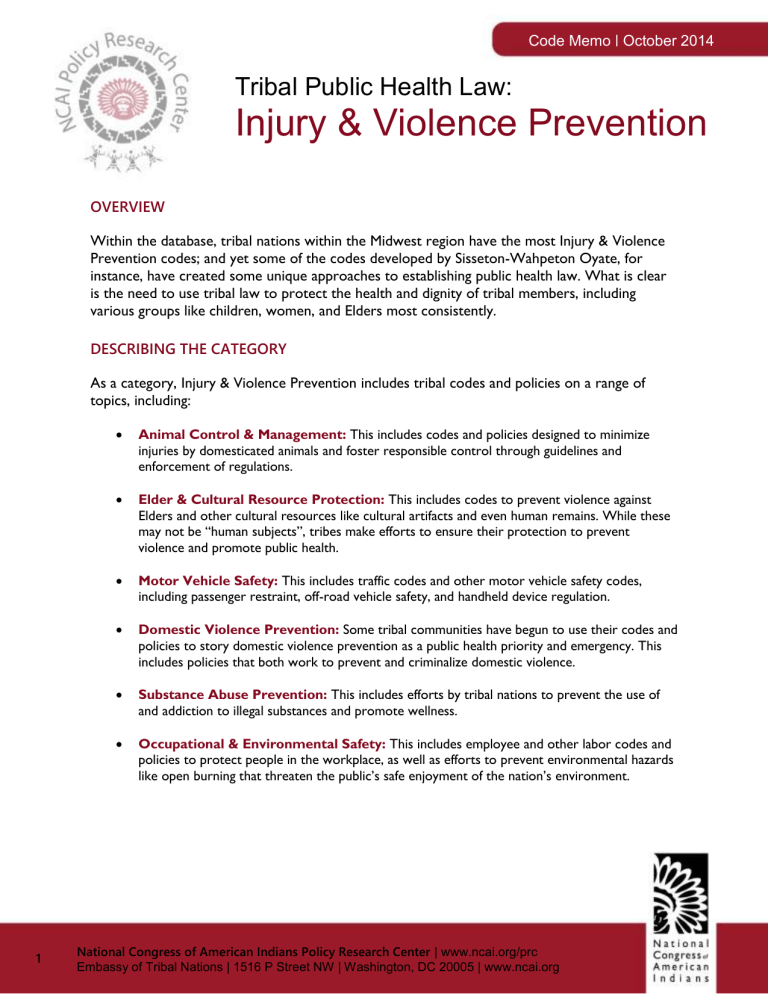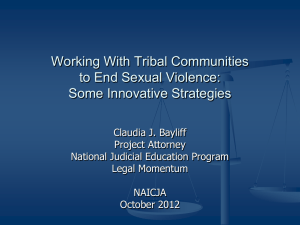Injury & Violence Prevention

Code Memo | October 2014
Tribal Public Health Law:
Injury & Violence Prevention
OVERVIEW
Within the database, tribal nations within the Midwest region have the most Injury & Violence
Prevention codes; and yet some of the codes developed by Sisseton-Wahpeton Oyate, for instance, have created some unique approaches to establishing public health law. What is clear is the need to use tribal law to protect the health and dignity of tribal members, including various groups like children, women, and Elders most consistently.
DESCRIBING THE CATEGORY
As a category, Injury & Violence Prevention includes tribal codes and policies on a range of topics, including:
Animal Control & Management: This includes codes and policies designed to minimize injuries by domesticated animals and foster responsible control through guidelines and enforcement of regulations.
Elder & Cultural Resource Protection: This includes codes to prevent violence against
Elders and other cultural resources like cultural artifacts and even human remains. While these may not be “human subjects”, tribes make efforts to ensure their protection to prevent violence and promote public health.
Motor Vehicle Safety: This includes traffic codes and other motor vehicle safety codes, including passenger restraint, off-road vehicle safety, and handheld device regulation.
Domestic Violence Prevention: Some tribal communities have begun to use their codes and policies to story domestic violence prevention as a public health priority and emergency. This includes policies that both work to prevent and criminalize domestic violence.
Substance Abuse Prevention: This includes efforts by tribal nations to prevent the use of and addiction to illegal substances and promote wellness.
Occupational & Environmental Safety: This includes employee and other labor codes and policies to protect people in the workplace, as well as efforts to prevent environmental hazards like open burning that threaten the public’s safe enjoyment of the nation’s environment.
1
National Congress of American Indians Policy Research Center
| www.ncai.org/prc
Embassy of Tribal Nations | 1516 P Street NW | Washington, DC 20005 | www.ncai.org
Code Memo | October 2014
TRIBAL EXAMPLES
The Ely Shoshone Tribe’s, “Chapter 202. Crimes Against Public Health and Safety” includes various provisions that elucidate how one tribe frames public health, including those related to: alcoholic beverages; the poisoning or adulterating of food, water, or medicine; advertising goods and services to produce miscarriage; advertising treatment, cure or prevention of sexual disorders; tobacco; weapons such as concealed firearms, tear gas bombs and weapons; acts of terrorism and weapons of mass destruction; public nuisances; and crimes against children.
The Fond du Lac Band of Lake Superior Chippewa has set out a “Policy on Violence and Drugs for Fond du Lac Housing” to prevent violence in community provided housing. It states that
“Acts of violence by a tenant or resident of housing which is owned or administered by the
Fond du Lac Band of Lake Superior Chippewa are contrary to the health, safety and well-being of the people of the Fond du Lac Band, and shall as a matter of the public policy of the Fond du
Lac Band be grounds for eviction from such housing.”
The Sisseton-Wahpeton Sioux Adult Protection Code (Chapter 48) defines as its purpose:
“To prohibit abuse and neglect of disabled adults, to require reporting of all cases of suspected abuse or neglect of disabled adults, to provide for adult protective services and to provide a penalty for
substantiated cases of abuse or neglect.”
The Code defines penalties for those convicted of violations and specifies that spiritual treatment does not in itself constitute neglect or abuse to ensure cultural practices that Elders choose to participate in or have conducted are not framed as abuse. It also calls for the establishment of a registry to catalogue and track these abuses community wide.
Further, in its Domestic Violence Ordinance (Chapter 52), Sisseton-Wahpeton Oyate describes why tribal code and policy are important in promoting public health by preventing domestic violence:
“Violence against family members is not in keeping with traditional Dakota values…The goal of this ordinance is to provide victims of domestic violence with safety and protection…It is also the goal to be consistent with traditional Dakota values and, as such the criminal justice system will be utilized to impose consequences upon offenders for behaviors that violate traditional Dakota values that hold women and children as sacred…The problem of domestic violence within the boundaries of the Sisseton-
Wahpeton Sioux Tribe is seriously impacting the ability of the tribe to provide for the health and wellbeing of its tribal members and threatens the political integrity of the tribe.”
2
National Congress of American Indians Policy Research Center
| www.ncai.org/prc
Embassy of Tribal Nations | 1516 P Street NW | Washington, DC 20005 | www.ncai.org
Code Memo | October 2014
In its Treatment of Prisoners Code (Chapter 31), there are provisions to ensure the health of prisoners that include those related to the incarceration facilities (e.g., fresh air, access to adequate clothing, bedding, food, and shower facilities), exercise and sport, and medical services
(including nursing support for new mothers). In provisions related to education and recreation for prisoners, the code states that “Recreational and cultural activities shall be provided in all institutions for the benefit of the mental and physical health of prisoners”, which reflects a specific notion of public health.
The Leech Lake Band of Ojibwe has a policy related to the “Use of Handheld Personal
Communication Devices” and an “Off-Highway Vehicle Code” that promote road safety in ways that are reflective of specific threats to safety and how tribal citizens use the roads.
The Ho-Chunk Nation has an extensive Occupational Safety and Health Program Act within its
Personnel, Employment and Labor Code (Title 6, Section 8) that seeks to prevent injury (e.g., electrical and fire safety, indoor air quality, fall prevention) and violence in the workplace.
The Ho-Chunk Nation has a Domestic Abuse Act (Title 4, Section 5), which describes the public health and other welfare issues created by domestic abuse; there is a provision to prevent stalking and to prevent employers from terminating employees who have missed work due to domestic abuse proceedings; there are also protections for advocates and community officers and limitations on firearm possession from those with an active Temporary Restraining Order; and there are requirements related to the establishment of a domestic abuse prevention plan.
NOTES FOR THE FIELD
A large number of tribes have developed Elder Protection Codes and Adult Protection Codes to protect vulnerable adults alongside prevention efforts in domestic contexts and with children.
Injury and violence prevention codes are reflective of unique tribal contexts in that some emphasize workplace safety, others domestic context safety, and others public health and safety in facilities housing prisoners.
Some tribes have also begun to develop codes to regulate boxing, wrestling, and other unarmed combat to address the increased interest in sports like mixed martial arts (MMA) on reservations, including Tohono O’odham (see Title 17 Health and Safety, Chapter 5) and the
Confederated Tribes of the Umatilla Indian Reservation (see Criminal Code, Section 4.181).
3
National Congress of American Indians Policy Research Center
| www.ncai.org/prc
Embassy of Tribal Nations | 1516 P Street NW | Washington, DC 20005 | www.ncai.org









